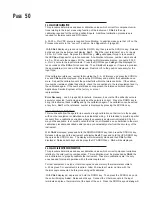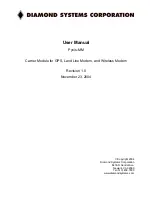
P
AGE
37
7. The Auto Tune Deviation upper limit AduL serves 2 functions: (which depend upon the
Auto Tune Select option parameter selected, see step 46 on page 33).
A. If the Auto Tune Select option ASo = 0, then the process value (temperature)
must be less then the setpoint value minus the AduL value in order for the
Auto Tune to function. Auto Tune will not function if the PV > SP - AduL.
Example: if PV = 200, SP = 230 and AduL = 50, the Auto Tune will not
function (see Appendix B, page 68).
B. If ASo = 1 and the process value is greater than the setpoint value minus
AduL, the heating out1 control output will be turned off when the AUTO
TUNE key is pressed. When the process value drops below the setpoint
value minus the AduL value, the heating control output will be turned on so
the Auto Tune function can begin (see Appendix B, page 68).
Note: In order for AduL to have an effect on Auto Tune, the AduL value must
be greater than 20 degrees or 5 % of the setpoint value, whichever is greater,
initiating the Auto Tune function.
8. Auto Tune Deviation lower limit AdLL:
A. If AdLL = 0 when the Auto Tune key is pressed the Auto Tune process
response calculations will begin when the process value reaches the point
1/2 way between the setpoint value and the process value at the time when
the AUTO TUNE key was pressed. Example: If SP = 1200 and PV = 400,
then the response calculations will be considered when the PV > 800.
B. If AdLL > 0, when the Auto Tune key is pressed, the Auto Tune process
response calculations will begin when the process value rises above the point
that is the result of subtracting 1/2 of the AdLL value from the setpoint value.
9. Auto Tune setpoint upper limit ASuL sets a maximum setpoint limit over which the
auto tune will not initiate. Typically selected at application maximum setpoint value
plus 10%.
10. Auto Tune setpoint lower limit ASLL sets a minimum setpoint limit under which the
Auto Tune will not work. ASLL must be lower than ASuL (see Appendix B, page 68)
11. The Control Response Criteria CrC is used to select the desired type of control
response for the process. Selecting 1.0 will provide good response to system upsets
but may allow overshooting of the setpoint. Selecting a value of 2.0 may result in a
slow response to system upsets but provide a stable process control. Selecting
values between 1.0 and 2.0 will result in process control somewhere between the two
extremes described. Actual process response will depend upon the application.
12. Control algorithm choice CAC allows selection of the type of control that best suits the
process. For example, if the process acts a little unstable after Auto Tuning with PID
selected, changing to the CAC PI and re-Auto Tuning may improve process stability.
13. Auto Tune abort option AAo is used to select what the controller will do if the Auto
Tune function can not complete. Select the AAo parameter code that is best for your
application.
14. Auto Tune time limit AtL selects a time limit that will cause the Auto Tune to abort if
the process response calculations have not been completed. Start at 0, no time
limit, if unfamiliar with the process reaction time needed.
15. The Auto Tune on demand ASo parameter, if selected as 0, will disable the Auto
Tune function when the process variable is within the AduL value below setpoint. If
ASo is selected as 1, the Auto Tune will work when the process variable is within the
AduL value below setpoint as described in number 6 previously (page 37).
















































